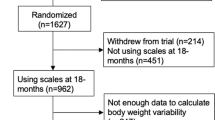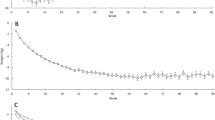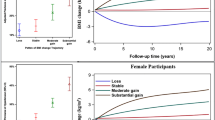Abstract
Background/Objectives:
Dietary weight loss interventions have heterogeneous outcomes in long-term studies, with many participants regaining part or all of the lost weight. Growth mixture modelling is a novel analytic approach that can be used to identify different trajectories of weight change during a trial rather than focussing on the total amount of weight lost.
Subjects/Methods:
Data were pooled from two 12-month dietary weight loss studies where no significant difference was detected between the treatment and control arms, thus allowing analysis independent of treatment. The data set included 231 subjects (74.5% female), with a mean weight loss of 6.40 kg (4.96). Growth mixture models were used to identify participants with similar trajectories of change in body mass index (BMI).
Results:
Three subgroups were identified. A rapid and continuing BMI loss over the study period (rapid, n=53), a rapid initial weight loss in the first 3 months with a slowing rate over the remaining 9 months (maintainers, n=146) and those with an initial loss trajectory, which slowed and began to increase at 9 months (recidivists, n=53). Age (s.d.) and BMI (s.d.) were significantly different between the three groups (rapid 53 years (7), 28.99 kg/m2 (3.30); maintainers 47 years (9), 30.90 kg/m2 (2.95); recidivists 44 years (7), 34.84 kg/m2 (1.92), both P<0.001).
Conclusions:
Older subjects with lower BMIs were more likely to have a rapid and continuing weight loss in a 1-year dietary-based weight loss intervention. Different interventional approaches may be necessary for different ages and baseline BMIs and stratification prior to randomisation may be necessary to prevent confounding in weight loss trials.
This is a preview of subscription content, access via your institution
Access options
Subscribe to this journal
Receive 12 print issues and online access
$259.00 per year
only $21.58 per issue
Buy this article
- Purchase on Springer Link
- Instant access to full article PDF
Prices may be subject to local taxes which are calculated during checkout


Similar content being viewed by others
References
Ng M, Fleming T, Robinson M, Thomson B, Graetz N, Margono C et al. Global, regional, and national prevalence of overweight and obesity in children and adults during 1980–2013: a systematic analysis for the Global Burden of Disease Study 2013. Lancet 2014; 384: 766–781.
MacLean PS, Wing RR, Davidson T, Epstein L, Goodpaster B, Hall KD et al. NIH working group report: innovative research to improve maintenance of weight loss. Obesity 2014; 23: 7–15.
Blackburn G . Effect of degree of weight loss on health benefits. Obesity Res 1995; 3: 211s–216s.
Neiberg RH, Wing RR, Bray GA, Reboussin DM, Rickman AD, Johnson KC et al. Patterns of weight change associated with long-term weight change and cardiovascular disease risk factors in the Look AHEAD Study. Obesity (Silver Spring) 2012; 20: 2048–2056.
Jung T, Wickrama KAS . An introduction to latent class growth analysis and growth mixture modeling. Soc Personal Psychol Compass 2008; 2: 302–317.
Muthen B, Brown HC, Hunter A, Cook IA, Leuchter AF . General approaches to the analysis of course: applying growth mixture modeling to randomized trials of depression medication. In: Shrout PE (ed.) Causality and Psychopathology: Finding the Determinants of Disorders and Their Cures. Oxford University Press: New York, NY, USA. pp 159–178, 2011.
Muthen B, Muthen LK . Integrating person-centered and variable-centered analyses: growth mixture modeling with latent trajectory classes. Alcohol Clin Exp Res 2000; 24: 882–891.
Tapsell LC, Batterham MJ, Thorne RL, O'Shea JE, Grafenauer SJ, Probst YC . Weight loss effects from vegetable intake: a 12-month randomised controlled trial. Eur J Clin Nutr 2014; 68: 778–785.
Tapsell LC, Batterham MJ, Charlton KE, Neale EP, Probst YC, O'Shea JE et al. Foods, nutrients or whole diets: effects of targeting fish and LCn3PUFA consumption in a 12mo weight loss trial. BMC Public Health 2013; 13: 1231.
Baecke JA, Burema J, Frijters JE . A short questionnaire for the measurement of habitual physical activity in epidemiological studies. Am J Clin Nutr 1982; 36: 936–942.
Bauer DJ, Curran PJ . Distributional assumptions of growth mixture models: implications for overextraction of latent trajectory classes. Psychol Methods 2003; 8: 338–363.
Rindskopf D . Mixture or homogeneous? Comment on Bauer and Curran. Psychol Methods 2003; 8: 364–368. discussion 384-393.
Muthen B . Statistical and substantive checking in growth mixture modeling: comment on Bauer and Curran. Psychol Methods 2003; 8: 369–377. discussion 384-393.
Franz MJ, VanWormer JJ, Crain AL, Boucher JL, Histon T, Caplan W et al. Weight-loss outcomes: a systematic review and meta-analysis of weight-loss clinical trials with a minimum 1-year follow-up. J Am Diet Assoc 2007; 107: 1755–1767.
de Vos BC, Runhaar J, Verkleij SP, van Middelkoop M, Bierma-Zeinstra SM . Latent class growth analysis successfully identified subgroups of participants during a weight loss intervention trial. J Clin Epidemiol 2014; 67: 947–951.
Espeland MA, Bray GA, Neiberg R, Rejeski WJ, Knowler WC, Lang W et al. Describing patterns of weight changes using principal components analysis: results from the Action for Health in Diabetes (Look AHEAD) research group. Ann Epidemiol 2009; 19: 701–710.
Wadden TA, Bantle JP, Blackburn GL, Bolin P, Brancati FL, Bray GA et al. Eight-year weight losses with an intensive lifestyle intervention: the look AHEAD study. Obesity (Silver Spring) 2014; 22: 5–13.
Kaiser KA, Gadbury GL . Estimating the range of obesity treatment response variability in humans: methods and illustrations. Human Hered 2013; 75: 127–135.
Poulson RS, Gadbury GL, Allison DB . Treatment heterogeneity and individual qualitative interaction. Am Stat 2012; 66: 16–24.
Deram S, Villares SM . Genetic variants influencing effectiveness of weight loss strategies. Arq Bras Endocrinol Metabol 2009; 53: 129–138.
Singer JD, Willett JB . Modeling change using covariance structure analysis. In: Applied Longitudinal Data Analysis. Oxford University Press: New York, NY, USA, pp 266–302, 2003.
Fitzmaurice G, Davidan M, Verbeke G, Molenberghs G . Longitudinal Data Analysis. Chapman & Hall/CRC: Boca Raton, FL, USA, 2009.
Stull DE, Houghton K . Identifying differential responders and their characteristics in clinical trials: innovative methods for analyzing longitudinal data. Value Health 2013; 16: 164–176.
Rosenbaum M, Hirsch J, Gallagher DA, Leibel RL . Long-term persistence of adaptive thermogenesis in subjects who have maintained a reduced body weight. Am J Clin Nutr 2008; 88: 906–912.
Rosenbaum M, Leibel RL . Adaptive responses to weight loss. In: Kushner RF, Bessesen DH (eds). Treatment of the Obese Patient. Springer: New York, NY, USA, pp 97–115, 2014.
Sumithran P, Prendergast LA, Delbridge E, Purcell K, Shulkes A, Kriketos A et al. Long-term persistence of hormonal adaptations to weight loss. N Engl J Med 2011; 365: 1597–1604.
Erez G, Tirosh A, Rudich A, Meiner V, Schwarzfuchs D, Sharon N et al. Phenotypic and genetic variation in leptin as determinants of weight regain. Int J Obes 2011; 35: 785–792.
Jenkins AB, Campbell LV . Future management of human obesity: understanding the meaning of genetic susceptibility. Adv Genomics Genet 2014; 4: 219–232.
Thomas DM, Ivanescu AE, Martin CK, Heymsfield SB, Marshall K, Bodrato VE et al. Predicting successful long-term weight loss from short-term weight-loss outcomes: new insights from a dynamic energy balance model (The POUNDS Lost study). Am J Clin Nutr 2015; 101: 449–454.
Thomas DM, Martin CK, Heymsfield S, Redman LM, Schoeller DA, Levine JA . A simple model predicting individual weight change in humans. J Biol Dyn 2011; 5: 579–599.
Acknowledgements
Funding for the studies was provided by the Australian National Health and Medical Research Council (Project Grant Number 514631) and by Horticulture Australia Limited using the vegetable levy and matched funding from the Australian Government.
Author information
Authors and Affiliations
Corresponding author
Ethics declarations
Competing interests
The authors declare no conflict of interest.
Rights and permissions
About this article
Cite this article
Batterham, M., Tapsell, L. & Charlton, K. Baseline characteristics associated with different BMI trajectories in weight loss trials: a case for better targeting of interventions. Eur J Clin Nutr 70, 207–211 (2016). https://doi.org/10.1038/ejcn.2015.45
Received:
Revised:
Accepted:
Published:
Issue Date:
DOI: https://doi.org/10.1038/ejcn.2015.45
This article is cited by
-
Weight Loss After Sleeve Gastrectomy: Does Type 2 Diabetes Status Impact Weight and Body Composition Trajectories?
Obesity Surgery (2021)
-
Determinants of successful lifestyle change during a 6-month preconception lifestyle intervention in women with obesity and infertility
European Journal of Nutrition (2019)
-
Weight loss and mortality risk in patients with different adiposity at diagnosis of type 2 diabetes: a longitudinal cohort study
Nutrition & Diabetes (2018)
-
A Randomized Controlled Trial of Dapagliflozin Plus Once-Weekly Exenatide Versus Placebo in Individuals with Obesity and Without Diabetes: Metabolic Effects and Markers Associated with Bodyweight Loss
Diabetes Therapy (2018)



